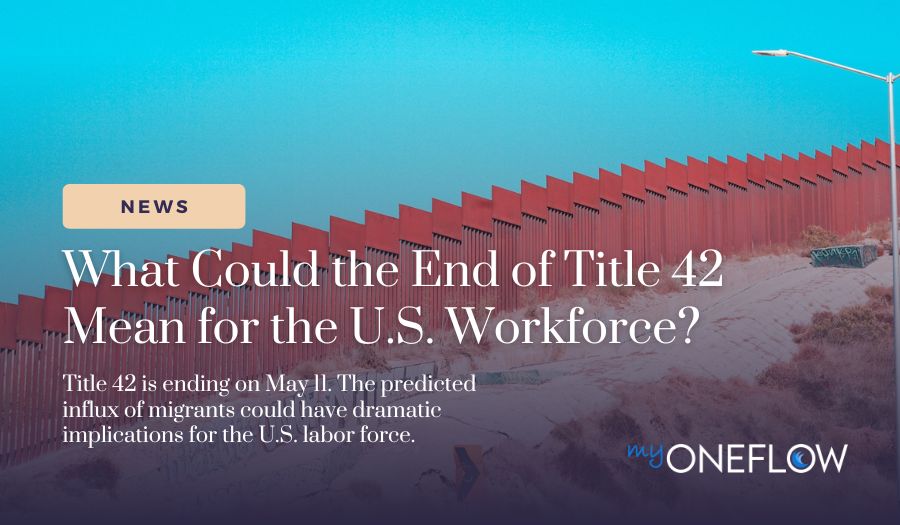4 Signs You Need to Modernize Your WIOA Case Management Solution
In an age of sleek software, automated processes, and personalized workflows, we expect a certain level of sophistication from our technology. We...
3 min read
 Emily Sleister
Jan 6, 2023 6:05:09 AM
Emily Sleister
Jan 6, 2023 6:05:09 AM

Updated 4/29/2023
Title 42 is a provision of U.S. health law that allows border officials to prohibit individuals from entering the country for public health reasons. It was invoked in March 2020 due to concerns about COVID-19 transmission and has since been used nearly 3 million times to turn away migrants without processing their asylum claims. Title 42 is set to expire on May 11 with the coinciding end of the national COVID-19 public health emergency.
Title 42 has been controversial since its inception, as seeking asylum is an internationally recognized human right protected by federal law through the Refugee Act of 1980. Many public health officials have criticized the policy. They argue that it did little to stem the spread of COVID during the height of the pandemic and is even less justifiable now that other international borders are open to travel.
Ironically, Title 42 has increased overall border encounters since many migrants attempt repeat border crossings shortly after being turned away. In fact, one report found that nearly half of Title 42 expulsions were repeat border crossers.
One undeniable fact, however, is that Title 42 has been highly effective in contributing to the dramatic decrease in immigration over the past years, to the detriment of the U.S. labor force. While legal immigration has been on a gradual decline since 2016, it plummeted by 50% between 2019 and 2021.
The current labor shortage has many complex causes, but the impact of an immigration slowdown cannot be understated. Some economists estimate that up to half of the missing labor force can be attributed to the lack of immigration – millions of jobs. According to a 2020 report from the Migration Policy Institute, immigrant-origin workers (immigrants and their U.S.-born children) “were responsible for 83% of labor force growth between 2010 and 2018, at which point they made up 28% of all U.S. workers.”
Unsurprisingly, many industries with the highest rates of unfilled jobs also rely on high rates of immigrant labor, such as manufacturing, hospitality, transportation, and healthcare.
The current administration’s stance on Title 42 has been somewhat murky. After the CDC released a statement in April 2022 stating that the policy was no longer necessary due to decreased COVID numbers, Biden officials announced plans to end it. However, the decision was blocked by a Louisiana District Court.
In September, Biden himself stated that “the pandemic is over.” Then, in October, the administration made a deal with the Mexican government to expand Title 42 to include Venezuelan migrants seeking asylum. While the agreement does offer a narrow pathway to asylum for Venezuelans, it is contingent on the continuation of Title 42 to turn away migrants who do not qualify and has left thousands of families stranded at the Mexico-U.S. border. On January 5, the administration expanded the policy again to include migrants from Cuba, Haiti, and Nicaragua.
Despite the confusing legislative back-and-forth, Title 42 will expire on May 11. Officials project a spike in daily border crossings that could see upwards of 13,000 migrants per day - close to double the current numbers. Immigration officials are working to prepare for the influx with new migration processing centers in Latin America designed to help migrants access legal pathways into the U.S.
The chaos surrounding the termination of Title 42 is just one piece of our dysfunctional immigration system. The statistics paint a bleak picture: even with the decrease in asylum applicants, there were still nearly half a million pending asylum applications as of spring 2022. The pandemic exacerbated chronic backlogs in immigration court – as of June 2022, there were close to 2 million open cases. On average, individuals who are ultimately granted asylum wait over four years before they receive a determination.
While asylum-seekers are typically permitted to live and work in the U.S. as they await a court decision, this lengthy process can leave their families separated and often stranded in dangerous situations in their home countries. The uncertainty of limbo also disincentivizes individuals from pursuing long-term educational and career opportunities that could help support their families and bolster the U.S. workforce.
The end of Title 42 will hopefully reopen the door for more migrants and asylum-seekers to legally begin entering the United States. However, massive systemic reform is needed to adequately process and support these individuals in building safe, self-sustaining lives for themselves and their families.
While immigrant communities contribute to our society in ways that extend far beyond the economy, working towards a healthier immigration system is critical to rectifying the labor shortage and strengthening our workforce. As Secretary of Homeland Security, Alejandro Mayorkas, noted in a recent statement, “despite our efforts, our outdated immigration system is under strain . . . A real solution can only come from legislation that brings long-overdue and much-needed reform to a fundamentally broken system.”

In an age of sleek software, automated processes, and personalized workflows, we expect a certain level of sophistication from our technology. We...

Data breaches are costly and common. The average cost of a data breach in the U.S. is $9.44 million, and every second, 68 records are either lost or...

This article was last updated on 1/30/2025 According to the Department of Labor, "WIOA is landmark legislation that is designed to strengthen and...